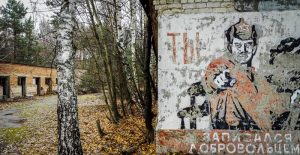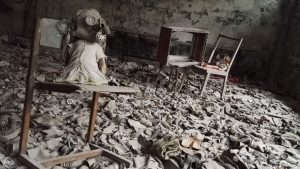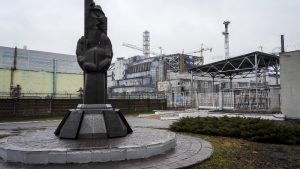Overcast skies seemed suddenly appropriate
We hadn’t seen the sun for two weeks. On the six-day train ride from Beijing to Moscow it hadn’t mattered much – half the time had been spent guzzling cheap vodka frantically purchased during our 20-minute stops in various Siberian towns, and the other half with the shades drawn, wishing we hadn’t. Once we had arrived in Moscow the consistently overcast sky had become a bit more of an annoyance, and by the time we reached Kiev it was a regular source of complaint. But on this long, early-morning bus journey to the site of the Chernobyl disaster, the grey expanse stretching above us seemed suddenly appropriate. Just eight hours ago our group of 30 had been holed up in a packed bar, downing beer after beer with the locals while excitedly cheering on the Ukrainian football team as they vied for one of the few remaining World Cup spots.
 Now the mood had taken a turn for the somber – perhaps hangovers were beginning to set in, but it probably had more to do with the documentary that had been informing of us of precisely how tragic and devastating the events of April 26, 1986, had been for the region that we were now visiting as curious tourists. Suicide rescue missions and children dying of radiation poisoning have a way of killing the mood. The screen abruptly went blank, our guide stood up: we had arrived. As we slowly emerged from the bus we were greeted by shrines, trees covered in ribbons, and warning signs with the radioactive symbol stamped on them, but it was clear we hadn’t really arrived anywhere except a checkpoint. We were crossing the outermost border of the Exclusion Zone – more formally known as the Chernobyl Nuclear Power Plant Zone of Alienation.
Now the mood had taken a turn for the somber – perhaps hangovers were beginning to set in, but it probably had more to do with the documentary that had been informing of us of precisely how tragic and devastating the events of April 26, 1986, had been for the region that we were now visiting as curious tourists. Suicide rescue missions and children dying of radiation poisoning have a way of killing the mood. The screen abruptly went blank, our guide stood up: we had arrived. As we slowly emerged from the bus we were greeted by shrines, trees covered in ribbons, and warning signs with the radioactive symbol stamped on them, but it was clear we hadn’t really arrived anywhere except a checkpoint. We were crossing the outermost border of the Exclusion Zone – more formally known as the Chernobyl Nuclear Power Plant Zone of Alienation.
 Once through, we were right back on the bus and cruising down a long, empty, forest-lined road, along which traces of abandoned buildings could be seen among the trees. According to our guide, the government of Ukraine had allowed several elderly former residents to repopulate the outermost Exclusion Zone in the last few years, but there was certainly no trace of them here. Everything was dead. After 15 minutes we came to another checkpoint, and then were back on the road. When we finally came to a small village where we disembarked it was a bit of a shock — there were signs of life here after all. Two elderly men on bicycles had stopped to chat after grabbing some groceries. There were a number of small buildings that were clearly being put to use, although they were heavily outnumbered by the abandoned ones. And the lawns were well manicured enough that one could almost be forgiven thinking he had taken a wrong turn and ended up in a quaint Ukrainian hamlet.
Once through, we were right back on the bus and cruising down a long, empty, forest-lined road, along which traces of abandoned buildings could be seen among the trees. According to our guide, the government of Ukraine had allowed several elderly former residents to repopulate the outermost Exclusion Zone in the last few years, but there was certainly no trace of them here. Everything was dead. After 15 minutes we came to another checkpoint, and then were back on the road. When we finally came to a small village where we disembarked it was a bit of a shock — there were signs of life here after all. Two elderly men on bicycles had stopped to chat after grabbing some groceries. There were a number of small buildings that were clearly being put to use, although they were heavily outnumbered by the abandoned ones. And the lawns were well manicured enough that one could almost be forgiven thinking he had taken a wrong turn and ended up in a quaint Ukrainian hamlet.
But the ubiquitous statues, plaques, and murals memorializing the victims of the disaster ensured that nobody here could ever forget, even for a moment, the events of April 1986 and the following weeks, when the Soviet Union fought to contain the greatest environmental catastrophe in history. After a brief explanation from our guide and a little exploration, we were back on the bus, heading to the power plant. But on the way, it seemed our guide had other ideas. He called for the driver to pull over, and led us outside. We’d have to be quick, he said – this wasn’t part of the standard tour. Behind a silver, ageing statue we saw a dilapidated wooden building. On further inspection, it was an abandoned kindergarten. Long forgotten dolls and books littered the floor, the paint was peeling, and the local flora had begun to reclaim the area. Things were starting to get dark.
Closing in on the epicentre
 Back to the bus, and finally to the site of the disaster itself. As we approached our guide readied his hand-held Geiger counter. He had previously demonstrated to us just how safe being in the exclusion zone was – for a limited amount of time, of course. As he described it, a day in the Exclusion Zone would irradiate you no more than a four or five hour plane ride. It made me wonder whether Chernobyl was perfectly safe — or I should be taking more trains? But we weren’t just in the Exclusion Zone now, we were less than 100 yards from the reactor itself, albeit encased in thick concrete and covered with tons of sand and earth. However, much to my surprise, the most interesting thing at the site wasn’t the infamous reactor, but what was about to be put on top of it — the “sarcophagus,” a massive steel arch which, when finished, would completely enclose the original reactor and aim to protect the outside world from its contents for those 50,000 years – or at least get started on it.
Back to the bus, and finally to the site of the disaster itself. As we approached our guide readied his hand-held Geiger counter. He had previously demonstrated to us just how safe being in the exclusion zone was – for a limited amount of time, of course. As he described it, a day in the Exclusion Zone would irradiate you no more than a four or five hour plane ride. It made me wonder whether Chernobyl was perfectly safe — or I should be taking more trains? But we weren’t just in the Exclusion Zone now, we were less than 100 yards from the reactor itself, albeit encased in thick concrete and covered with tons of sand and earth. However, much to my surprise, the most interesting thing at the site wasn’t the infamous reactor, but what was about to be put on top of it — the “sarcophagus,” a massive steel arch which, when finished, would completely enclose the original reactor and aim to protect the outside world from its contents for those 50,000 years – or at least get started on it.
We had seen the site of the worst nuclear disaster in history, and learned a great deal about the events of the day and the resulting fallout. But we had one more stop to make, and this was what we had come for. We were going to Pripyat, a ghost city, where one day life had simply stopped being lived and the entire population had been evacuated. They were told they would be able to come back in a few days, and thus all possessions were left behind, creating a still-life frozen in place for almost three decades. And we were going exploring.
Not all irradiated cities are evacuated — check out the secret Soviet settlement of City 40!





